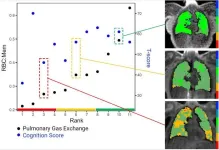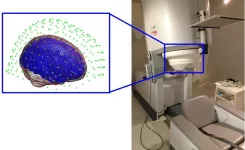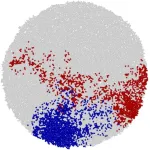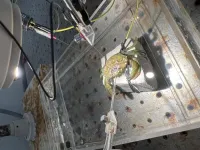(Press-News.org) CHICAGO – In patients with long COVID, lower pulmonary gas exchange may be associated with impaired cognitive function, according to a study being presented next week at the annual meeting of the Radiological Society of North America (RSNA).
According to the National Center for Health Statistics, approximately 17.6% of adults in the U.S. have experienced a post-COVID condition commonly referred to as long COVID. People with long COVID may exhibit a wide variety of symptoms, including difficulty concentrating (“brain fog”), change in sense of smell or taste, fatigue, joint or muscle pain, dyspnea (shortness of breath), digestive symptoms, and more. These symptoms may persist for weeks, months, or even years after COVID-19 infection.
Researchers from the University of Iowa in Iowa City set out to assess associations between pulmonary MRI gas exchange, structural and functional brain MRI, and cognition in long COVID patients. In pulmonary gas exchange, oxygen moves from the lungs to the bloodstream, while carbon dioxide moves from the bloodstream to the lungs.
“This is the first time that MRI has been used to jointly assess lung and brain function to investigate their relationship in long COVID,” said the study’s lead author Keegan Staab, B.S., graduate research assistant in the Department of Radiology at the University of Iowa in Iowa City. “This research is new in that it combines multiple unique imaging types to study a multiorgan relationship in a disease population.”
Senior study author Sean B. Fain, Ph.D., professor and vice chair for research in the Department of Radiology at the University of Iowa, added, “If these findings can be generalized to the long COVID population, the study suggests that there may be a causative relationship between cognitive dysfunction and lung dysfunction, suggesting a potential treatment strategy using methods that target improved gas exchange.”
For the study, 10 female and 2 male patients (median age: 59 years) who had persistent dyspnea and/or fatigue following the resolution of acute COVID-19 infection were recruited from a post-COVID-19 clinic. Hyperpolarized Xe pulmonary MRI, structural and functional brain MRI, pulmonary function tests and cognitive tests were acquired.
“129Xe MRI allows for advanced measurements of ventilation and gas exchange,” Staab said. “The literature also indicates that 129Xe may be more sensitive to pulmonary injury compared to standard breathing tests, making it better suited to study long COVID in which patients typically have normal breathing tests.”
Perceived cognitive difficulties were measured using Patient-Reported Outcomes Measurement Information System, and objective cognitive performance was assessed using the National Institutes of Health Toolbox V3 Cognition Battery.
“There was a range of cognitive difficulties among the patients in the study,” Staab said. “Some were mild and indicated slight dysfunction, while others were more serious and indicated that some patients have slow thinking and trouble concentrating several times per day.”
The results showed that lower pulmonary gas exchange may be associated with cognitive dysfunction, as well as lower gray matter and white matter volumes in patients with long COVID. In addition, the researchers observed significant relationships suggesting that increased cerebral blood flow is associated with decreased gas exchange in long COVID patients.
Staab said larger studies are needed to investigate the association between gas exchange and cerebral blood flow in long COVID.
“This relationship could be a compensatory mechanism where lower lung function is compensated by higher cardiac output and higher brain perfusion,” he said. “It’s also a possibility that the disease mechanism that impairs pulmonary gas exchange also leads to higher brain perfusion through downstream vascular injury in both lung and brain.”
Based on the findings of this study, gas exchange abnormalities may help identify long COVID patients who require additional treatment or long-term management.
Other co-authors are Marrissa J. McIntosh, Ph.D., Jonathan L. Percy, B.S., Andrew D. Hahn, Ph.D., Natally AlArab, M.D., Conner J. Wharff, B.S. B.A. RT(R)(MR), Eric Bruening, M.S., Alejandro P. Comellas, M.D., Eric A. Hoffman, Ph.D., Carinda Linkenmeyer, M.A.E., Tara Lanning, B.S., and Karin F. Hoth, Ph.D.
###
Note: Copies of RSNA 2024 news releases and electronic images will be available online at RSNA.org/press24.
RSNA is an association of radiologists, radiation oncologists, medical physicists and related scientists promoting excellence in patient care and health care delivery through education, research and technologic innovation. The Society is based in Oak Brook, Illinois. (RSNA.org)
For patient-friendly information on MRI, visit RadiologyInfo.org.
END
CHICAGO – A new study of high school football players found that concussions affect an often-overlooked but important brain signal. The findings are being presented next week at the annual meeting of the Radiological Society of North America (RSNA).
Reports have emerged in recent years warning about the potential harms of youth contact sports on developing brains. Contact sports, including high school football, carry a risk of concussion. Symptoms of concussion commonly include cognitive disturbances, such as difficulty with balancing, ...
Laboratory experiments with cancer cells reveal two ways in which tumors evade drugs designed to starve and kill them, a new study shows.
While chemotherapies successfully treat cancers and extend patients’ lives, they are known not to work for everyone for long, as cancer cells rewire the process by which they convert fuel into energy (metabolism) to outmaneuver the drugs’ effects. Many of these drugs are so-called antimetabolics, disrupting cell processes needed for tumor growth and survival.
Three such drugs used in the study — raltitrexed, N-(phosphonacetyl)-l-aspartate (PALA), and brequinar ...
Climate change is the single biggest threat to the global environment and socio-economic development – demanding an urgent transformation of the United Nations’ Sustainable Development Goals (SDGs), according to a new study.
The UN SDGs were created to end poverty, build social-economic-health protection and enhance education and job opportunities, while tackling climate change and providing environmental protection.
Following last week’s COP29 environmental summit in Baku, University of Birmingham experts say that, as climate action is linked to sustainable development, systematic integration of climate resilience into every ...
UNDER STRICT EMBARGO UNTIL 10.00AM (UK TIME) ON 26 NOVEMBER 2024
New study reveals genetic drivers of early onset type 2 diabetes in South Asians
Peer reviewed | Observational study | People
A genetic predisposition to having lower insulin production and less healthy fat distribution are major causes of early-onset type 2 diabetes in British Asian people. According to new research from Queen Mary University of London, these genetic factors also lead to quicker development of health complications, earlier need for insulin treatment, and a weaker response ...
RICHLAND, Wash. —Tip the first tile in a line of dominoes and you’ll set off a chain reaction, one tile falling after another. Cross a tipping point in the climate system and, similarly, you might spark a cascading set of consequences like hastened warming, rising sea levels and increasingly extreme weather.
It turns out there’s more to weigh than catastrophic environmental change as tipping points draw near, though. Another point to consider, a new study reveals, is the cost of undoing the damage.
The cost of reversing the effects of climate change—restoring melted polar sea ice, for ...
While Jupiter's Great Red Spot has been a constant feature of the planet for centuries, University of California, Berkeley, astronomers have discovered equally large spots at the planet's north and south poles that appear and disappear seemingly at random.
The Earth-size ovals, which are visible only at ultraviolet wavelengths, are embedded in layers of stratospheric haze that cap the planet's poles. The dark ovals, when seen, are almost always located just below the bright auroral zones at each ...
Researchers at the University of Cologne and the Centre for Genomic Regulation (CRG) in Barcelona have discovered that cancer grows uniformly throughout its mass, rather than at the outer edges. The work, published today in the journal eLIFE, challenges decades-old assumptions about how the disease grows and spreads.
“We challenge the idea that a tumour is a ‘two-speed’ entity with rapidly dividing cells on the surface and slower activity in the core. Instead, we show they are uniformly growing masses, where every region is equally active and has the potential ...
The Arctic is warming two to four times faster than the global average. A recent study by researchers in Japan found that dust from snow- and ice-free areas of the Arctic may be an important contributor to climate change in the region. The findings were published in the journal npj Climate and Atmospheric Science.
According to one view, higher temperatures in the Arctic are thought to lead to the region's clouds containing more liquid droplets and fewer ice crystals. Clouds become thicker, longer lasting, ...
Researchers from the University of Gothenburg are the first to prove that painful stimuli are sent to the brain of shore crabs providing more evidence for pain in crustaceans. EEG style measurements show clear neural reactions in the crustacean's brain during mechanical or chemical stimulation.
In the search for a better welfare of animals that we humans kill for food, researchers at the University of Gothenburg have chosen to focus on decapod crustaceans. This includes shellfish delicacies such as prawns, lobsters, crabs and crayfish that we both catch wild and farm. Currently, ...
Social stress is bad for your brain. It’s a prime suspect in the accumulation of oxidative stress in the brain, which is believed to contribute to mental health and neurodegenerative disorders — but the mechanisms that turn social stress into oxidative stress, and how social status affects this, are poorly understood. By studying a highly social, very hierarchical fish species, cichlids, scientists have now found that social stress raises oxidative stress in the brains of low-status fish.
“We found that low rank was generally linked to higher levels of oxidative stress in the brain,” said Dr Peter Dijkstra of ...






